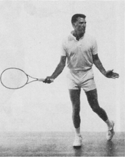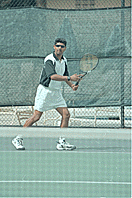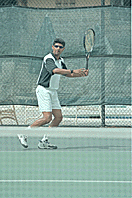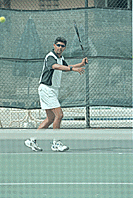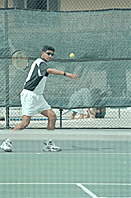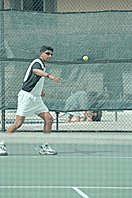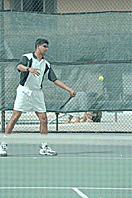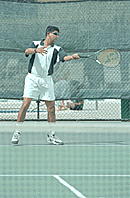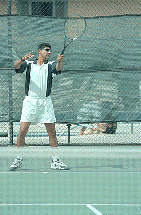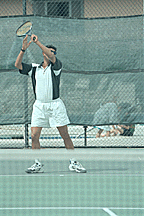|
TennisOne Lesson
The Loop Forehand, Part 1
QuestionI have a loopy backswing on my forehand racquet take back. I use a semi-western grip to get lots of topspin on the ball. The problem I am running into is when I am faced with an opponent who mixes up the spin and pace on the ball. I seem to frame the ball a lot and not find my range or rhythm. My friends tell me I should eliminate my loopy backswing. I don't want to do that because the loopy backswing gives me a lot of pace and topspin. What should I do? AnswerClick here to see animation of loop forehand. Not to worry. Most loopers have problems with opponents who topspin on one side and keep the ball low with slices on the other. By knowing when to loop and when to take it straight back, you'll find your range and rhythm. In Part 1 of this lesson lets start off with the what, who, why and how of the loopy forehand. Once you understand it, then we can go into detail in Part 2 of the lesson on when and how to make adjustments so it becomes easier for you to time certain types of balls. Classic Style--Racquet Straight Back
If you watch Chang, Agassi, Hingis and Muster closely, you will notice this loopy backswing. The style of the loopy backswing may vary from player to player depending on what type of surface they grew up on, but the general bio-mechanics are all the same. For instance, a European player who grew up on a slower surface like clay may have a slightly bigger loop than for a player who grew up playing fast hard courts. Some may start the loop with the elbow and while others may start it with the tip of the racquet. The loopy backswing is primarily done to get more racquet speed by way of momentum. Since the racquet is going up first and then down and then up and through towards the ball, the racquet will have a lot more head speed than just taking it straight back and forward. This basically means, you can hit through the ball faster without having to muscle your swing in order to get more pace and spin. Modern Style--Loopy Backswing
The loopy backswing on the forehand is done by taking the racquet back with a semi-circle motion rather than the conventional straight back method. My opponent has hit the ball and it is coming towards me. With a good shoulder turn I am in the process of setting my racquet back. Pay particular attention on where the racquet head is at this moment. If I were to take my racquet straight back, it would probably be at the same height as my hips. With my looping take-back, notice the head of the racquet slightly above my shoulder.
Here, you can see the ball in the frame. By this time, my racquet head and my hand has already been set below the height of the ball. This is extremely important to get plenty of topspin on the ball. By getting under the ball, I can brush up towards it and make contact. To visualize this, imagine brushing the trunk of a horse up rather than down.
Click here to see animation of loop forehand. Send email to the author We encourage you to email your comments (pro, con, appreciative, whatever)
directly to the author. To send email to Monty Basnyat, click
here. Go To: Back to TennisONE Home Page webmaster@tennisone.com
|
